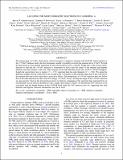LOCATING THE MOST ENERGETIC ELECTRONS IN CASSIOPEIA A
Author(s)
Grefenstette, Brian W.; Reynolds, Stephen P.; Harrison, Fiona A.; Humensky, T. Brian; Boggs, Steven E.; Fryer, Chris L.; DeLaney, Tracey; Madsen, Kristin K.; Miyasaka, Hiromasa; Wik, Daniel R.; Zoglauer, Andreas; Forster, Karl; Kitaguchi, Takao; Nynka, Melania; Christensen, Finn E.; Craig, William W.; Hailey, Charles J.; Stern, Daniel; Zhang, William W.; Lopez, Laura A.; ... Show more Show less
DownloadGrefenstette-2015-LOCATING THE MOST EN.pdf (1.548Mb)
PUBLISHER_POLICY
Publisher Policy
Article is made available in accordance with the publisher's policy and may be subject to US copyright law. Please refer to the publisher's site for terms of use.
Terms of use
Metadata
Show full item recordAbstract
We present deep (>2.4 Ms) observations of the Cassiopeia A supernova remnant with NuSTAR, which operates in the 3–79 keV bandpass and is the first instrument capable of spatially resolving the remnant above 15 keV. We find that the emission is not entirely dominated by the forward shock nor by a smooth "bright ring" at the reverse shock. Instead we find that the >15 keV emission is dominated by knots near the center of the remnant and dimmer filaments near the remnant's outer rim. These regions are fit with unbroken power laws in the 15–50 keV bandpass, though the central knots have a steeper (Γ ~ −3.35) spectrum than the outer filaments (Γ ~ −3.06). We argue this difference implies that the central knots are located in the 3-D interior of the remnant rather than at the outer rim of the remnant and seen in the center due to projection effects. The morphology of >15 keV emission does not follow that of the radio emission nor that of the low energy (<12 keV) X-rays, leaving the origin of the >15 keV emission an open mystery. Even at the forward shock front we find less steepening of the spectrum than expected from an exponentially cut off electron distribution with a single cutoff energy. Finally, we find that the GeV emission is not associated with the bright features in the NuSTAR band while the TeV emission may be, suggesting that both hadronic and leptonic emission mechanisms may be at work.
Date issued
2015-03Department
MIT Kavli Institute for Astrophysics and Space ResearchJournal
The Astrophysical Journal
Publisher
IOP Publishing
Citation
Grefenstette, Brian W., Stephen P. Reynolds, Fiona A. Harrison, T. Brian Humensky, Steven E. Boggs, Chris L. Fryer, Tracey DeLaney, et al. “LOCATING THE MOST ENERGETIC ELECTRONS IN CASSIOPEIA A.” The Astrophysical Journal 802, no. 1 (March 16, 2015): 15. © 2015 The American Astronomical Society
Version: Final published version
ISSN
1538-4357
0004-637X